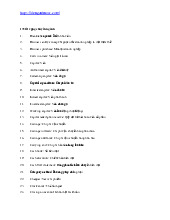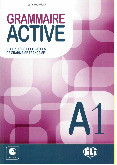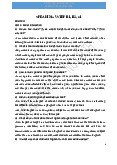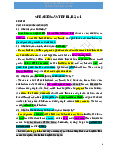

Preview text:
Midterm test preparation
A Brief Description of CLT 1. What is CL T?
CLT is an approach to language teaching that emphasizes interaction and
communicative competence as both the means and the ultimate goal of study.
This approach does not focus on linguistic or grammatical competence but
rather communicative competence, which helps students could genuinely
communicate outside the classroom. 2. Sever
al important principles of CLT:
Teaching goal: ability to communicate in the target language.
Means of learning: through using the target language to communicate.
Class size: Students work in pairs or groups-> transfer and negotiate
meaning in situations in which one person has the information that the other lack.
Materials: authentic, promote communicative language use.
Activities: in a meaningful situation or context and have a communicative
purpose(role play, games, problem-solving tasks, or dramatization)
Fluency is an important dimension of communication -> provide students
with opportunities to develop both accuracy and fluency.
Integration of different language skills
Learning is a process of creative construction and involves trial and error. Teacher:
+ facilitate communication, guide, instructor, monitor, participant, ->give feedback and correct errors.
+use the target language fluently and appropriately.
Learner roles: active- contribute as much as they can, are negotiator,
interact primarily with each other rather than with the teacher.
The content of language course: +semantic notions +social function
=> are as important as linguistic structures.
3. Advise whether CLT is compatible to the context of TEFL in Vietnam.
Unlike traditional methods used for a long time in VN, CLT has been likely to be
the most dominant and recommended method in meeting the Vietnamese
students' needs of communication in English and is the best method in Asian area.
Support CLT as the most suitable method for English language teaching context in VN.
Many modern linguists claim: The purpose of language learning is to acquire
'communicative competence', that is giving more importance on language
function rather than grammatical competence. Students in Viet Nam have been
lacking communicative competence in English even though many students have
a wide range of vocabulary and grammar. Therefore, CLT emerged as an more
effective method, which can assist learners achieve their goals of
communicative competence compared with other traditional methods.
With the rapid development of VN, Vietnamese's living standards are getting
higher and higher, infrastructures and facilities are becoming better and more
convenient to meet the needs of using CLT method.
The English level proficiency of both teachers and students in Viet Nam are
getting higher and higher than in the past, many people achive high IELTS
scores and the ability to speak and pronounce correctly is also improving. Thus,
Vietnamese educational system are certainly able to employ CLT as the main
approach to English language teaching.
Vietnamese students are also active and dynamic enough to learn in CLT class.
This approach will promote the student's creativity and the ability to use
English in a natural way without any script.
Although preparing for a lesson applying CLT is not easy, the use of CLT in
teaching is completely compatible to the context of TEFL in Vietnam.




